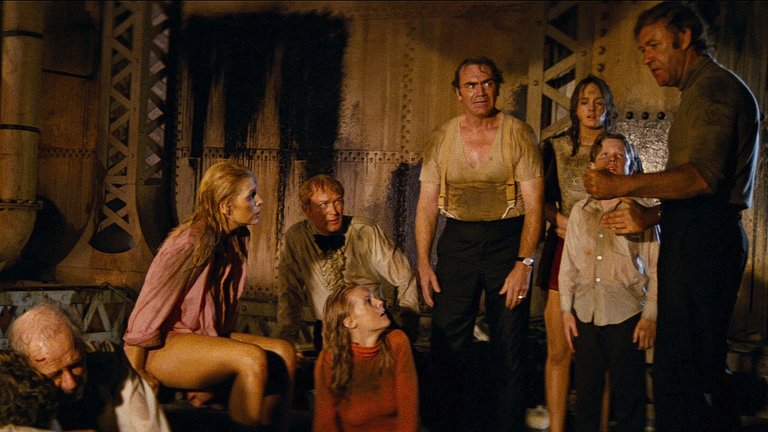Film Review: The Poseidon Adventure (1972)

If one name epitomises the disaster film genre, it is Irwin Allen, the producer whose grandiose 1970s oeuvre showcased Hollywood’s technical prowess at its zenith. Though George Seaton’s Airport (1970) catalysed the trend, Allen’s 1972 production of The Poseidon Adventure, directed by Ronald Neame, solidified the genre’s commercial viability. With its audacious set pieces and star-studded ensemble, the film became a cultural touchstone, marrying suspense with spectacle. Allen, dubbed the "Master of Disaster," transformed a capsized ocean liner into a claustrophobic battlefield, proving that calamity could be both terrifying and irresistibly entertaining.
Adapted from Paul Gallico’s 1969 bestseller, The Poseidon Adventure retains the novel’s core premise while excising its more lurid elements. Gallico’s tale of existential struggle amidst maritime ruin provided fertile ground for screenwriters Stirling Silliphant and Wendell Mayes, who distilled its essence into a taut, character-driven narrative. The film jettisons the novel’s gratuitous subplots, focusing instead on the visceral immediacy of survival. This streamlined approach foregrounds human resilience over melodrama, a decision that would prove pivotal to the film’s enduring appeal.
The ill-fated SS Poseidon, an ageing luxury liner on its final voyage from New York to Athens, becomes a microcosm of societal collapse. Pressured by cost-cutting owners, Captain Harrison (Leslie Nielsen, in a rare serious role) forgoes ballast protocols, rendering the vessel vulnerable. As passengers ring in the New Year, an undersea earthquake triggers a colossal wave that flips the ship upside down. The ensuing catastrophe leaves a handful of survivors trapped in an inverted labyrinth of debris and flooding corridors. Their dilemma is stark: await a dubious rescue or ascend through the ship’s bowels towards the propeller shaft, where the hull is thinnest.
Leading the latter faction is Reverend Frank Scott (Gene Hackman), a maverick cleric whose mantra—“God helps those who help themselves”—clashes with the passive piety of the ship’s chaplain. Hackman’s Scott is a compelling paradox: part messianic leader, part flawed mortal, his dogged determination galvanises the group even as his hubris risks their lives. The motley crew—a resourceful Mrs. Rosen (Shelley Winters) and her husband Manny (Jack Albertson), a gruff police detective Lt. Rogo (Ernest Borgnine) and his ex-prostitute wife Linda (Stella Stevens), and a traumatised singer (Carol Lynley)—embody disparate facets of humanity under duress. Their odyssey through the ship’s wreckage, a gauntlet of fire, water, and structural decay, is as much a psychological trial as a physical one.
The Poseidon Adventure was a commercial juggernaut, grossing over $125 million globally. Critics, however, were less effusive, praising its technical achievements while deriding its narrative contrivances. The film secured two Academy Awards: Best Original Song for “The Morning After” and a Special Achievement Award for its groundbreaking visual effects. These accolades underscored Hollywood’s growing reliance on technical wizardry, a trend that would define 1970s cinema. Yet, many reviewers dismissed the film as a “guilty pleasure,” its emotional beats overshadowed by spectacle.
The film’s technical triumph lies in its ability to conjure grandeur from confinement. Shot partly aboard the RMS Queen Mary and on meticulously crafted studio sets, the capsized Poseidon is a masterclass in immersive design. Corridors dangle precariously, ballrooms become vertical death traps, and engine rooms exude a sulphurous menace. Cinematographer Harold E. Stine’s chiaroscuro lighting amplifies the hellish atmosphere, transforming the ship into a character in its own right. This juxtaposition of opulence and ruin—a chandelier-encrusted dining room now a tomb—serves as a potent metaphor for human fragility.
Silliphant and Mayes’ script elevates the film beyond mere disaster porn. By fleshing out its ensemble, the narrative fosters genuine investment in their fates. Shelley Winters’ Mrs. Rosen, an overweight retiree haunted by her former swimming prowess, emerges as the film’s emotional anchor. Her heroic dive to unlock a watertight door—a moment both ludicrous and stirring—subverts expectations of the “helpless matron” trope. Similarly, Ernest Borgnine’s Det. Mike Rogo evolves from abrasive misanthrope to selfless leader, his arc a testament to the script’s nuanced characterisation. The decision to defy Hollywood’s star-survival conventions—several A-list actors perish early—lends the film a jarring unpredictability.
The cast’s commitment elevates the material, even when dialogue veers into cliché. Gene Hackman’s fiery sermons and Shelley Winters’ poignant vulnerability are standouts, while Leslie Nielsen’s stoic captain hints at the comedic genius he would later embrace. However, the script’s reliance on trite aphorisms occasionally undermines its gravitas. The contrived New Year’s Eve setting—a narrative device to maximise festive irony—stretches credulity, reminding viewers they are in the realm of Hollywood artifice.
The Poseidon Adventure’s success spawned a genre boom, culminating in Allen’s The Towering Inferno (1974), often hailed as the disaster film’s apotheosis. Reuniting screenwriter Silliphant, composer John Williams, and singer Maureen McGovern (whose rendition of “The Morning After” remains iconic), Inferno refined Allen’s formula of star power and spectacle. Yet, Poseidon’s raw intensity remains unmatched, its legacy enduring in films like Titanic (1997) and Gravity (2013).
Allen’s 1979 sequel, Beyond the Poseidon Adventure, epitomised the genre’s creative bankruptcy. Plagued by ludicrous plotting and campy execution, it flopped resoundingly. Subsequent adaptations—a bloated 2005 TV film and Wolfgang Petersen’s 2006 Poseidon—fared worse, their reliance on CGI spectacle paling against the original’s practical ingenuity. These failures underscore a truism: disaster films thrive not on scale alone, but on the human stakes at their core.
The Poseidon Adventure remains a benchmark of 1970s cinema, a film whose technical bravura and emotional resonance transcend its flaws. While its dialogue may creak and its premise strain credulity, the film’s exploration of courage, sacrifice, and communal struggle retains a visceral power. In an age of sterile CGI spectacles, Poseidon’s claustrophobic grandeur and tactile authenticity remind us that disaster, when grounded in humanity, can be profoundly cathartic. Allen’s opus may not be high art, but as a testament to Hollywood’s golden age of spectacle, it is—pardon the pun—unsinkable.
RATING: 7/10 (+++)
Blog in Croatian https://draxblog.com
Blog in English https://draxreview.wordpress.com/
InLeo blog https://inleo.io/@drax.leo
Hiveonboard: https://hiveonboard.com?ref=drax
InLeo: https://inleo.io/signup?referral=drax.leo
Rising Star game: https://www.risingstargame.com?referrer=drax
1Inch: https://1inch.exchange/#/r/0x83823d8CCB74F828148258BB4457642124b1328e
BTC donations: 1EWxiMiP6iiG9rger3NuUSd6HByaxQWafG
ETH donations: 0xB305F144323b99e6f8b1d66f5D7DE78B498C32A7
BCH donations: qpvxw0jax79lhmvlgcldkzpqanf03r9cjv8y6gtmk9
Posted Using INLEO